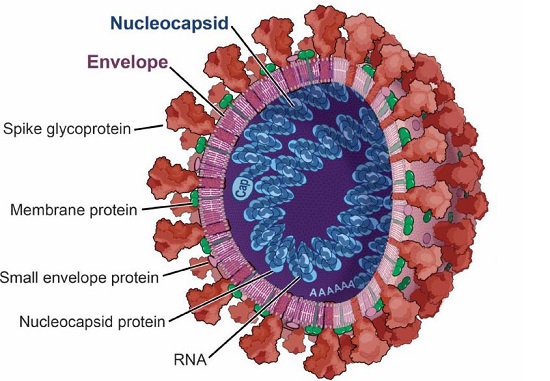New insights into the SARS-CoV-2 E and 3a proteins and their roles in virus assembly and immune response
Nikhil Prasad Fact checked by:Thailand Medical News Team Jul 27, 2024 1 year, 4 months, 4 weeks, 2 days, 23 hours, 30 minutes ago
COVID-19 News: Understanding SARS-CoV-2 Proteins
A recent study has delved into the intricacies of two key proteins of the SARS-CoV-2 virus, known as E and 3a proteins, highlighting their pivotal roles in the viral life cycle. This
COVID-19 News report explores the findings from research conducted by scientists from the U.S. National Institute on Drug Abuse, U.S. NIH and the University of Rochester, School of Medicine & Dentistry, New York-USA.
 New insights into the SARS-CoV-2 E and 3a proteins and their roles in virus assembly and immune response
The Role of E and 3a Proteins in SARS-CoV-2
New insights into the SARS-CoV-2 E and 3a proteins and their roles in virus assembly and immune response
The Role of E and 3a Proteins in SARS-CoV-2
SARS-CoV-2, the virus responsible for COVID-19, utilizes a variety of proteins to facilitate its replication and spread within the human body. Among these, the E and 3a proteins are particularly significant. These transmembrane proteins are crucial for the assembly, budding, and release of new viral particles. They form channels in the host cell membrane, allowing the transport of ions that favor viral replication. During an active infection, both proteins primarily localize to the endoplasmic reticulum (ER), ER-Golgi intermediate compartment (ERGIC), and the Golgi apparatus - sites critical for the proper packaging and trafficking of proteins.
Localization and Function of E and 3a Proteins
The research team quantified the distribution of SARS-CoV-2 E and 3a proteins along the secretory pathways in a human intestinal epithelial cell line. They first demonstrated that epitope-tagged E and 3a proteins, expressed via transfection, had similar subcellular immunoreactivity as the proteins expressed by wild-type viral infection. This similarity suggests that the tagging process did not alter the proteins' natural behavior.
Further analysis revealed that both E and 3a proteins localized with various cellular markers to different extents. Notably, the 3a protein showed a higher correlation with the Golgi, early and late endosomes, lysosomes, and the plasma membrane compared to the E protein. This finding indicates that the 3a protein has a broader impact on the cell's trafficking pathways.
Implications for Viral Replication and Host Response
The study's findings have important implications for understanding how SARS-CoV-2 manipulates host cells to its advantage. The ER and Golgi are vital for protein synthesis and transport, and the localization of E and 3a proteins in these areas suggests that they play significant roles in these processes. By altering the host cell's normal functions, these proteins help the virus replicate more efficiently and evade immune detection.
Moreover, the research highlights the potential of targeting these proteins for therapeutic interventions. Since both E and 3a proteins are involved in crucial steps of the viral life cycle, inhibiting their functions could disrupt the virus's ability to reproduce and spread. This approach could lead to the development of new antiviral drugs or
the repurposing of existing ones to combat COVID-19.
The Broader Impact of E and 3a Proteins
Beyond their roles in viral replication, the E and 3a proteins are also linked to other cellular processes. The ER is essential for maintaining cellular homeostasis, including protein folding and calcium balance. Disruptions in these processes can lead to various diseases, including neurodegenerative disorders, cardiovascular diseases, and cancer. The study suggests that by interfering with ER functions, SARS-CoV-2 could potentially exacerbate these conditions in infected individuals.
Future Research Directions
The research opens up several avenues for further investigation. For instance, understanding the exact mechanisms by which E and 3a proteins alter host cell functions could provide deeper insights into the virus's pathology. Additionally, studying the interactions between these proteins and other viral or host proteins could reveal new targets for therapeutic intervention.
Conclusion
This detailed examination of SARS-CoV-2 E and 3a proteins sheds light on their critical roles in the virus's life cycle and their broader impact on host cell functions. By manipulating key cellular pathways, these proteins help the virus replicate and evade immune responses, highlighting their potential as targets for antiviral therapies.
The study findings were published on a preprint server and are currently being peer reviewed.
https://papers.ssrn.com/sol3/papers.cfm?abstract_id=4902192
For the latest
COVID-19 News, keep on logging to Thailand Medical News.
Read Also:
https://www.thailandmedical.news/news/the-role-of-coronavirus-proteins-in-apoptosis-or-cell-death
https://www.thailandmedical.news/news/sars-cov-2-nucleocapsid-protein-prevents-viral-degradation-by-disrupting-nonsense-mediated-mrna-decay
